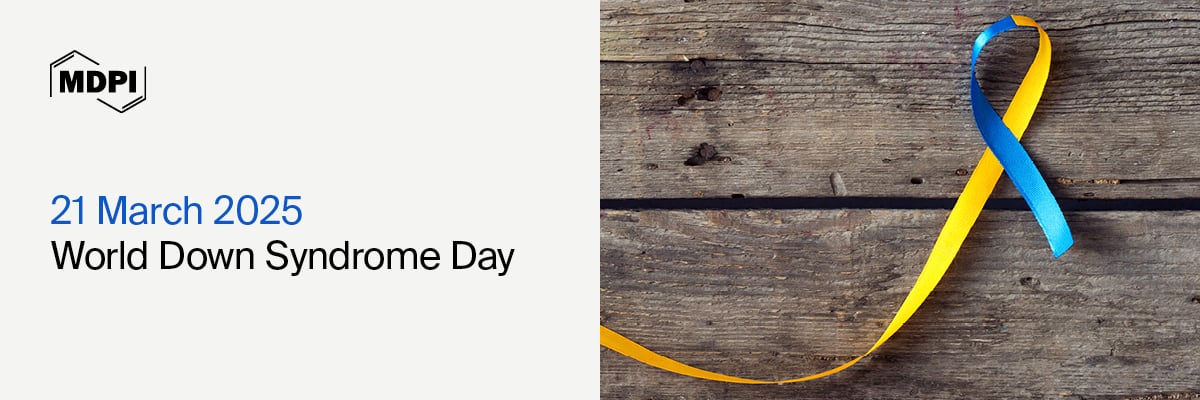-
 Proteinuria and Progression of Renal Damage: The Main Pathogenetic Mechanisms and Pharmacological Approach
Proteinuria and Progression of Renal Damage: The Main Pathogenetic Mechanisms and Pharmacological Approach -
 Sjögren’s Disease and Gastroesophageal Reflux Disease: What Is Their Evidence-Based Link?
Sjögren’s Disease and Gastroesophageal Reflux Disease: What Is Their Evidence-Based Link? -
 Impact of a Physical Exercise and Health Education Program on Metabolic Syndrome and Quality of Life in Postmenopausal Breast Cancer Women Undergoing Adjuvant Treatment with Aromatase Inhibitors
Impact of a Physical Exercise and Health Education Program on Metabolic Syndrome and Quality of Life in Postmenopausal Breast Cancer Women Undergoing Adjuvant Treatment with Aromatase Inhibitors -
 Alloimmune Causes of Recurrent Pregnancy Loss: Cellular Mechanisms and Overview of Therapeutic Approaches
Alloimmune Causes of Recurrent Pregnancy Loss: Cellular Mechanisms and Overview of Therapeutic Approaches -
 Circulating B Lymphocyte Subsets in Patients with Systemic Lupus Erythematosus
Circulating B Lymphocyte Subsets in Patients with Systemic Lupus Erythematosus
Journal Description
Medicina
Medicina
is an international, peer-reviewed, open access journal that covers all problems related to medicine. The journal is owned by the Lithuanian University of Health Sciences (LUHS) and is published monthly online by MDPI. Partner organizations are the Lithuanian Medical Association, Vilnius University, Rīga Stradiņš University, the University of Latvia, and the University of Tartu.
- Open Access— free for readers, with article processing charges (APC) paid by authors or their institutions.
- High Visibility: indexed within Scopus, SCIE (Web of Science), PubMed, MEDLINE, PMC, and other databases.
- Journal Rank: JCR - Q1 (Medicine, General and Internal) / CiteScore - Q1 (General Medicine)
- Rapid Publication: manuscripts are peer-reviewed and a first decision is provided to authors approximately 17.1 days after submission; acceptance to publication is undertaken in 2.5 days (median values for papers published in this journal in the second half of 2024).
- Recognition of Reviewers: reviewers who provide timely, thorough peer-review reports receive vouchers entitling them to a discount on the APC of their next publication in any MDPI journal, in appreciation of the work done.
Impact Factor:
2.4 (2023);
5-Year Impact Factor:
2.7 (2023)
Latest Articles
Incretin-Based Therapies and Cancer: What’s New?
Medicina 2025, 61(4), 678; https://doi.org/10.3390/medicina61040678 (registering DOI) - 7 Apr 2025
Abstract
Growing interest in incretin-based therapies for diabetes mellitus has led to an increased evaluation of their potential effects on cancer development. This review aims to synthesize recent evidence regarding the relationship between incretin-based therapies and cancer risk. We conducted a comprehensive literature review
[...] Read more.
Growing interest in incretin-based therapies for diabetes mellitus has led to an increased evaluation of their potential effects on cancer development. This review aims to synthesize recent evidence regarding the relationship between incretin-based therapies and cancer risk. We conducted a comprehensive literature review focusing on studies investigating dipeptidyl peptidase-4 (DPP-4) inhibitors, glucagon-like peptide-1 (GLP-1) receptor agonists, and dual GLP-1/glucose-dependent insulinotropic polypeptide (GIP) receptor agonists in relation to various malignancies. Current findings suggest that while these therapies demonstrate potential benefits, including weight reduction and metabolic regulation, concerns remain regarding their long-term safety profile. Notably, some studies indicate an increased risk of thyroid and pancreatic cancers, while others report protective effects against prostate, colorectal, and breast cancers. Given the complexity of their effects, further long-term studies and post-marketing surveillance are warranted. This review highlights the need for careful clinical assessment when prescribing incretin-based therapies to patients who may be at increased risk of cancer.
Full article
(This article belongs to the Special Issue Diabetes and Obesity: What is New in 2025)
Open AccessArticle
Patients’ Experiences Following Osteoarticular Foot Surgery for Rheumatoid Arthritis-Related Deformities: A Qualitative Study
by
Amparo Campos-Cano, Ana Belen Ortega-Avila, Salvador Diaz-Miguel, Alejandro Castillo-Domínguez, Eva Lopezosa-Reca, Gabriel Gijon-Nogueron, Laura Ramos-Petersen and Andrés Reinoso-Cobo
Medicina 2025, 61(4), 677; https://doi.org/10.3390/medicina61040677 (registering DOI) - 7 Apr 2025
Abstract
Background and Objectives: Rheumatoid arthritis (RA) is a chronic autoimmune disease that frequently causes foot deformities, decreasing mobility and quality of life. Although surgical interventions seek to alleviate these alterations, the long-term experiences of patients have not been deeply explored. The aim
[...] Read more.
Background and Objectives: Rheumatoid arthritis (RA) is a chronic autoimmune disease that frequently causes foot deformities, decreasing mobility and quality of life. Although surgical interventions seek to alleviate these alterations, the long-term experiences of patients have not been deeply explored. The aim of this study was to describe the experiences of patients with RA undergoing osteoarticular surgery to correct acquired foot deformities. Materials and Method: A qualitative study design was used with structured interviews including 19 patients with RA treated in a specialised rheumatology service. The thematic analysis was carried out using the Braun and Clarke thematic analysis, ensuring compliance with ethical standards and the anonymity of the participants. Results: Five main themes were identified: experience with pain before and after surgery; impact on functional capacity; complications and need for additional surgeries; emotional impact and quality of life; overall satisfaction with the surgery. While many patients reported significant pain reduction and functional improvements, others faced recurrences of the deformities, persistent pain, and post-surgical complications. Emotional responses ranged from well-being to frustration, depending on surgical outcomes. The five-year follow-up period allowed for a comprehensive assessment of the long-term impact of surgery. The recurrence rate of deformities was notable, and the emotional impact of these recurrences was significant, with patients expressing frustration and distress in some cases. Conclusions: The patients’ experiences were heterogeneous, with both positive and negative outcomes. These findings underscore the importance of individualized management and comprehensive follow-up that consider the clinical outcomes, expectations, and emotional well-being of RA patients undergoing foot surgery.
Full article
(This article belongs to the Section Orthopedics)
Open AccessSystematic Review
A Systematic Review and Meta-Analysis of MIP-1α and MIP-1β Chemokines in Malaria in Relation to Disease Severity
by
Saruda Kuraeiad, Kwuntida Uthaisar Kotepui, Aongart Mahittikorn, Nsoh Godwin Anabire, Frederick Ramirez Masangkay, Polrat Wilairatana, Kinley Wangdi and Manas Kotepui
Medicina 2025, 61(4), 676; https://doi.org/10.3390/medicina61040676 (registering DOI) - 6 Apr 2025
Abstract
Background and Objectives: Macrophage inflammatory protein-1α (MIP-1α) and MIP-1β act as signaling molecules that recruit immune cells to sites of infection and inflammation. This study aimed to synthesize evidence on blood levels of MIP-1α and MIP-1β in Plasmodium-infected individuals and to
[...] Read more.
Background and Objectives: Macrophage inflammatory protein-1α (MIP-1α) and MIP-1β act as signaling molecules that recruit immune cells to sites of infection and inflammation. This study aimed to synthesize evidence on blood levels of MIP-1α and MIP-1β in Plasmodium-infected individuals and to determine whether these levels differ between severe and uncomplicated malaria cases. Materials and Methods: The study protocol was registered in PROSPERO (CRD42024595818). Comprehensive literature searches were conducted in six databases (EMBASE, MEDLINE, Ovid, Scopus, ProQuest, and PubMed) to identify studies reporting blood levels of MIP-1α and MIP-1β in Plasmodium infections and clinical malaria. A narrative synthesis was used to describe variations in MIP-1α and MIP-1β levels between malaria patients and controls and between severe and non-severe malaria cases. Meta-analysis was used to aggregate quantitative data utilizing a random-effects model. Results: A total of 1638 records were identified, with 20 studies meeting the inclusion criteria. Most studies reported significantly higher MIP-1α and MIP-1β levels in malaria patients compared to non-malarial controls. The meta-analysis showed a significant elevation in MIP-1α levels in malaria patients (n = 352) compared to uninfected individuals (n = 274) (p = 0.0112, random effects model, standardized mean difference [SMD]: 1.69, 95% confidence interval [CI]: 0.38 to 3.00, I2: 96.0%, five studies, 626 individuals). The meta-analysis showed no difference in MIP-1α levels between severe malaria cases (n = 203) and uncomplicated cases (n = 106) (p = 0.51, SMD: −0.48, 95% CI: −1.93 to 0.96, I2: 97.3%, three studies, 309 individuals). Conclusions: This study suggests that while MIP-1α and MIP-1β levels are elevated in malaria patients compared to uninfected individuals, these chemokines show a limited ability to differentiate between severe and uncomplicated malaria or predict severe outcomes. Further research is needed to clarify their role in malaria pathogenesis and explore potential clinical applications.
Full article
(This article belongs to the Special Issue Infectious and Tropical Diseases: Symptoms, Diagnosis and Treatment)
►▼
Show Figures

Figure 1
Open AccessArticle
Remifentanil Patient-Controlled Analgesia for Labor Analgesia at Different Cervical Dilations: A Single Center Retrospective Analysis of 1045 Cases
by
Tatjana Stopar Pintaric, Lara Vehar, Alex T. Sia, Tomislav Mirkovic and Miha Lucovnik
Medicina 2025, 61(4), 675; https://doi.org/10.3390/medicina61040675 (registering DOI) - 6 Apr 2025
Abstract
Background and Objectives: Remifentanil is a potent synthetic μ-opioid receptor agonist known for its rapid onset and ultrashort duration of action, making it a popular choice for intravenous labor analgesia. The analgesic effectiveness of remifentanil patient-controlled analgesia (Remifentanil-PCA) may vary based on
[...] Read more.
Background and Objectives: Remifentanil is a potent synthetic μ-opioid receptor agonist known for its rapid onset and ultrashort duration of action, making it a popular choice for intravenous labor analgesia. The analgesic effectiveness of remifentanil patient-controlled analgesia (Remifentanil-PCA) may vary based on the stage of labor and parity, potentially influencing satisfaction with labor analgesia. This study aimed to evaluate the degree of pain reduction achieved with remifentanil-PCA, considering different cervical dilations in both nulliparous and multiparous women. Material and Methods: Women who were ≥37 weeks pregnant with singleton cephalic fetuses, either by spontaneous onset or induction of labor, were included in the study. Data were collected from the Labor Record form, which included demographic and obstetric information, as well as the onset of analgesia categorized by cervical dilation (1–3 cm, 4–6 cm, 7–9 cm, and full dilation). Additionally, data on analgesia onset and duration (the time interval between the start of analgesia and the delivery of the baby), initial numerical rating scale (NRS0) for pain intensity, NRS after the first hour of analgesia (NRS1), the lowest recorded NRS during labor (NRSmin), and pain reduction during the first hour of analgesia (NRS0–VAS1), satisfaction with labor analgesia (rated 0 for dissatisfied, 1 for moderately satisfied, 2 for very satisfied), and complication rates were obtained from the remifentanil-PCA form. Results: A total of 513 nulliparas and 523 multiparas who gave birth between 1 January 2019 and 31 December 2019 were reviewed. No significant differences were found between the two groups regarding age, body mass index, labor induction rates, occipito-posterior positioning, blood loss > 500 mL, or neonatal outcomes. Nulliparas exhibited a higher gestational age (p = 0.021), longer labor duration (p < 0.001), and increased rates of cesarean sections (p < 0.001) and vacuum extractions (p = 0.002). Remifentanil-PCA consistently provided mild to moderate pain intensity reduction. No differences were found in VAS0, VAS1, or pain intensity reduction (VAS0–VAS1) regardless of the stage of labor or parity. Significant differences in VAS min were observed among nulliparas at different stages of labor (p < 0.026). However, a higher proportion of multiparas reported moderate (24.7% vs. 9.5%, p < 0.001) and high satisfaction (90% vs. 75%, p < 0.001) with remifentanil-PCA compared to nulliparas. Importantly, no serious complications in mothers or neonates attributed to remifentanil-PCA were observed during the observational period. Conclusions: Remifentanil-PCA demonstrates consistent effectiveness regardless of the stage of labor or parity. This indicates that remifentanil-PCA can be administered at any point during labor. Coupled with its rapid availability and immediate analgesic effect, this feature enhances the flexibility of its use in clinical practice.
Full article
(This article belongs to the Section Intensive Care/ Anesthesiology)
►▼
Show Figures
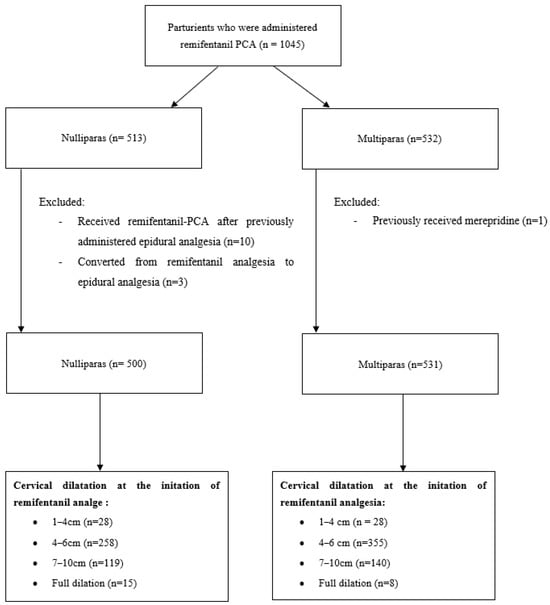
Figure 1
Open AccessArticle
A Comparison of the Results of Two Different Double-Row Repair Techniques in Arthroscopic Repair of Rotator Cuff Tears
by
Gökhan Ünlü, Mehmet Faruk Çatma, Ahmet Burak Satılmış, Tolgahan Cengiz, Serhan Ünlü, Mustafa Erdem and Önder Ersan
Medicina 2025, 61(4), 674; https://doi.org/10.3390/medicina61040674 (registering DOI) - 6 Apr 2025
Abstract
Background and Objectives: Shoulder pain, mainly involving rotator cuff tears, is a common type of musculoskeletal pain that significantly impairs quality of life. Arthroscopic rotator cuff repair has become the gold standard for treating symptomatic, full-thickness rotator cuff tears. Double-row repair techniques
[...] Read more.
Background and Objectives: Shoulder pain, mainly involving rotator cuff tears, is a common type of musculoskeletal pain that significantly impairs quality of life. Arthroscopic rotator cuff repair has become the gold standard for treating symptomatic, full-thickness rotator cuff tears. Double-row repair techniques are widely used because of their superior fixation and healing results. However, fewer implants may reduce treatment costs and raise questions about the impact on clinical outcomes and re-tear rates. This study compares the functional outcomes and re-tear rates of two transosseous-like double-row repair techniques: one anchor and one push lock (Group 1), and two anchors and two push locks (Group 2). Materials and Methods: A prospective, randomized, single-blind study was conducted on 53 patients undergoing arthroscopic repair for crescent-shaped rotator cuff tears (3–5 cm). Before surgery and 24 months after surgery, patients were evaluated for shoulder function using Constant–Murley scores and shoulder abduction angles. MRI was used to assess re-tear rates. Results: Both groups showed significant postoperative improvement in Constant scores (Group 1: 84.1; Group 2: 84.0; p > 0.05). Re-tear rates were slightly higher in Group 1 (23.1%) than in Group 2 (18.5%), but this was not statistically significant (p > 0.05). Shoulder abduction angles improved similarly between groups, with no significant difference in outcome. Despite higher costs and longer operative times, the two-anchor technique provided more stable fixation, but its functional outcomes were comparable to the single-anchor method. Conclusions: Using fewer implants in a double-row repair provides comparable functional outcomes and re-tear rates, and offers surgeons a cost-effective alternative, especially at the beginning of their learning curve. However, the two-anchor technique may be more beneficial in cases requiring improved mechanical stability. These findings provide valuable information to balance cost and effectiveness in rotator cuff repair.
Full article
(This article belongs to the Section Orthopedics)
►▼
Show Figures
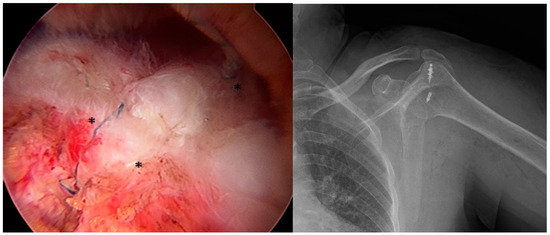
Figure 1
Open AccessReview
Optimizing Pulmonary Rehabilitation in Saudi Arabia: Current Practices, Challenges, and Future Directions
by
Fahad H. Alahmadi
Medicina 2025, 61(4), 673; https://doi.org/10.3390/medicina61040673 (registering DOI) - 6 Apr 2025
Abstract
Chronic respiratory diseases (CRDs) are a significantly major cause of mortality in Saudi Arabia, with their progression frequently involving comorbidities and exacerbations that extend beyond the lungs. This review considers the current state of pulmonary rehabilitation (PR) in Saudi Arabia, this being a
[...] Read more.
Chronic respiratory diseases (CRDs) are a significantly major cause of mortality in Saudi Arabia, with their progression frequently involving comorbidities and exacerbations that extend beyond the lungs. This review considers the current state of pulmonary rehabilitation (PR) in Saudi Arabia, this being a well-known non-pharmacological intervention to help control and reduce the burden of CRDs, highlighting the intervention’s availability, multidisciplinary approach, and integration within the healthcare system, as well as examining the diseases’ contribution to overall symptom severity, impairing daily activities and significantly worsening the patient’s quality of life. Although PR is strongly recommended for managing CRDs, its utilization in Saudi Arabia remains limited or unavailable in many regions. Key barriers to PR access include inadequate awareness among healthcare providers and patients, logistical challenges, and an insufficient number of specialized facilities and trained professionals. Expanding PR programs in Saudi Arabia requires addressing geographical barriers, ensuring adequate space, resources, and trained personnel, and raising awareness among healthcare providers through education and training. Integrating PR principles into medical education and offering incentives for specialization can help overcome personnel shortages. Additionally, promoting telerehabilitation can enhance patient compliance and ensure the long-term success of PR programs. These initiatives aim to optimize PR services and improve patient outcomes across the nation.
Full article
(This article belongs to the Section Infectious Disease)
►▼
Show Figures
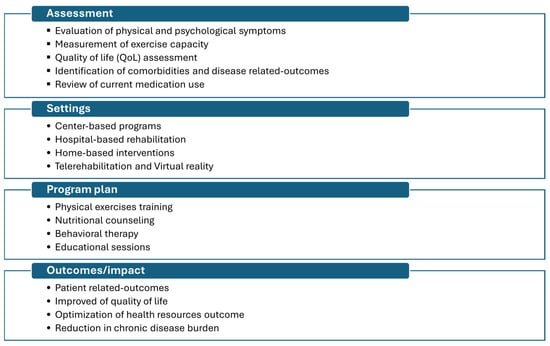
Figure 1
Open AccessReview
The Concept of Venous Steal: The Impact of Vascular Stenosis and Outflow Pressure Gradient on Blood Flow Diversion
by
Mindaugas Pranevičius, Dalius Makackas, Andrius Macas, Kęstutis Petrikonis, Gintarė Šakalytė, Osvaldas Pranevičius and Rimantas Benetis
Medicina 2025, 61(4), 672; https://doi.org/10.3390/medicina61040672 (registering DOI) - 6 Apr 2025
Abstract
Vascular steal refers to the diversion of blood flow between collateral vessels that share a common inflow restricted by arterial stenosis. Blood is diverted from the high-pressure to the low-pressure, low-resistance system. Vascular steal is associated with anatomical bypass or vasodilation in the
[...] Read more.
Vascular steal refers to the diversion of blood flow between collateral vessels that share a common inflow restricted by arterial stenosis. Blood is diverted from the high-pressure to the low-pressure, low-resistance system. Vascular steal is associated with anatomical bypass or vasodilation in the collateral network and is called “the arterial steal”. However, we have demonstrated that in the presence of an outflow gradient (e.g., intra-extracranial), blood is shunted to a lower pressure system, a phenomenon we term “venous steal”. Using Thevenin’s equivalent, we generalized the concept of venous steal to apply it to any region of the vascular system with increased outflow pressure. Both arterial steal, caused by increased collateral network conductivity, and venous steal, resulting from lower collateral outflow pressure, reduce compartment perfusion. This occurs indirectly by increasing flow and the pressure gradient across the arterial stenosis, lowering the segmental compartment perfusion pressure—the difference between post-stenotic (inflow) and compartmental (outflow) pressures. Venous steal diverts blood flow from compartments with elevated pressure, such as intracranial, subendocardial, the ischemic core, and regions of focal edema due to inflammation, trauma, or external compression. In shock and low-flow states, it contributes to regional blood flow maldistribution. Treatment of venous steal addresses inflow stenosis, increased compartmental pressure and systemic loading conditions (arterial and venous pressure) to reverse venous steal malperfusion in the ischemic regions.
Full article
(This article belongs to the Section Hematology and Immunology)
►▼
Show Figures
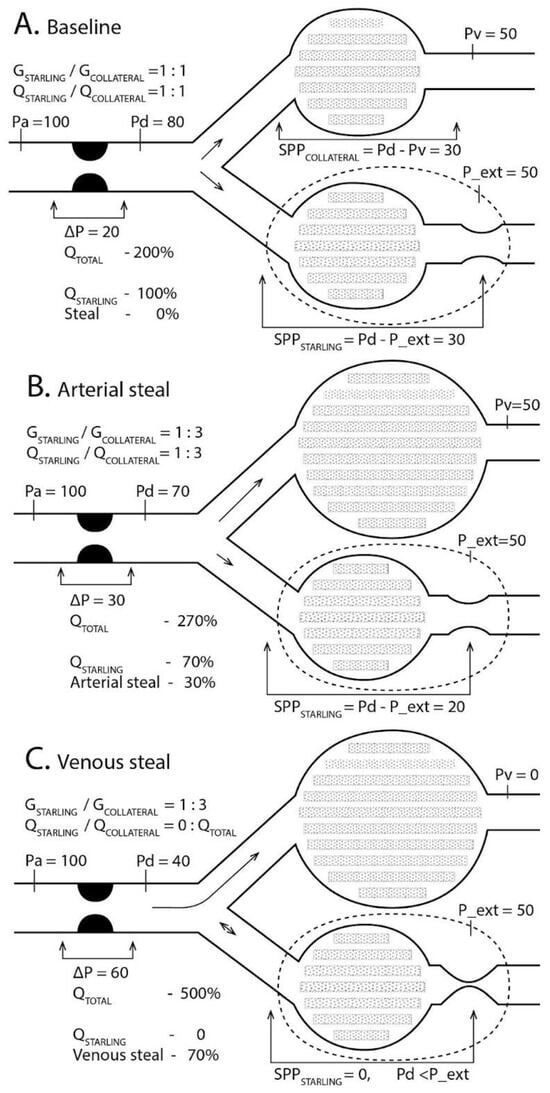
Figure 1
Open AccessArticle
Anatomical Variations in the Formation of the Sural Nerve: A Pilot Study in a Sample of Lithuanian Cadavers
by
Artur Airapetian, Benedikt Bachmetjev and Andrej Suchomlinov
Medicina 2025, 61(4), 671; https://doi.org/10.3390/medicina61040671 (registering DOI) - 5 Apr 2025
Abstract
Background and Objectives: The sural nerve (SN) is a pure sensory nerve that supplies the lateral aspect of the ankle and foot. Its anatomical variability has been extensively documented, with multiple classifications describing its different formation patterns. The SN is commonly used
[...] Read more.
Background and Objectives: The sural nerve (SN) is a pure sensory nerve that supplies the lateral aspect of the ankle and foot. Its anatomical variability has been extensively documented, with multiple classifications describing its different formation patterns. The SN is commonly used for nerve grafting and is a critical structure in lower-limb surgeries. Due to its superficial course, it is vulnerable to iatrogenic injuries, particularly in procedures involving the Achilles tendon. The presence of anatomical variations in SN formation and trajectory has significant implications for surgical planning, diagnostics, and nerve conduction studies. Understanding these formation variations is essential to minimize surgical complications and optimize clinical outcomes. Materials and Methods: A pilot cross-sectional cadaveric study was conducted on nine formalin-fixed adult cadavers at the Department of Anatomy, Histology, and Anthropology, Vilnius University Faculty of Medicine, Lithuania. Standard dissection techniques were employed to examine the formation and trajectory of the SN. Morphometric parameters, including nerve diameter and length, were measured using an RS PTO Digital Caliper with 0.01 mm precision. Variations in SN formation were classified according to the system proposed by P.K. Ramakrishnan et al. Statistical analyses were performed using SPSS 26.0 and RStudio, with a significance threshold set at p ≤ 0.05. Results: The most prevalent SN formation variation observed in the Lithuanian cadaveric sample was Type 3, which was found in 8 out of 18 limbs (44.4%), while Type 6 was not identified. Additionally, a symmetric formation was observed bilaterally in 5 out of the 9 cadavers (55.6%). The SN was significantly thicker in two-contributor formations (3.17 mm) compared to single-contributor formations (1.93 mm, p = 0.001). The SN was also significantly longer in two-contributor formations (25.80 cm) than in single-contributor formations (18.96 cm, p = 0.016). No significant differences in SN morphology were found between left and right lower limbs. Conclusions: This study highlights the substantial anatomical variability of the SN in the Lithuanian population. The findings suggest a correlation between SN diameter and formation type, which may have clinical implications for nerve grafting and surgical planning. The predominance of Type 3 formation and the observed symmetry rate provide valuable anatomical insights for lower limb surgeries. Further large-scale studies are necessary to establish population-specific SN variations and their relevance in clinical practice.
Full article
(This article belongs to the Section Orthopedics)
►▼
Show Figures
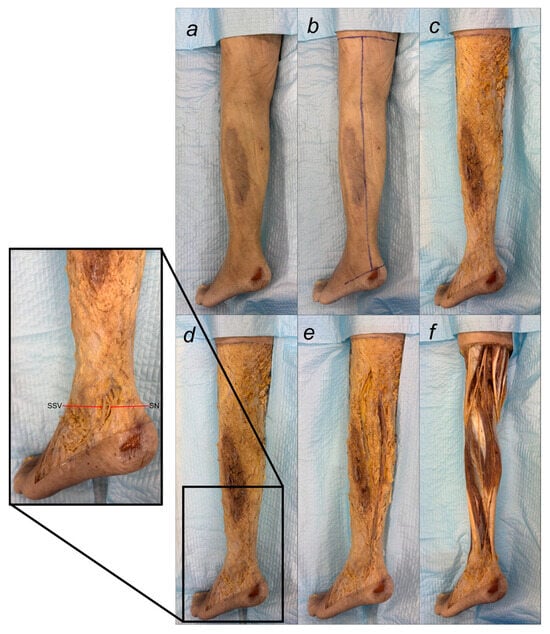
Figure 1
Open AccessArticle
Integrating RHD Genotyping for More Accurate Rh(D) Antigen Phenotyping: A Retrospective Study
by
Mohammad Barouqa and Nestor Dela Cruz
Medicina 2025, 61(4), 670; https://doi.org/10.3390/medicina61040670 (registering DOI) - 5 Apr 2025
Abstract
Background and Objectives: The Rh blood group system is highly polymorphic, and accurate classification of Rh(D) variants is critical in transfusion medicine to prevent alloimmunization and optimize blood utilization. Despite the advances in conventional serologic testing, weak and partial Rh(D) phenotypes still remain
[...] Read more.
Background and Objectives: The Rh blood group system is highly polymorphic, and accurate classification of Rh(D) variants is critical in transfusion medicine to prevent alloimmunization and optimize blood utilization. Despite the advances in conventional serologic testing, weak and partial Rh(D) phenotypes still remain challenges in Transfusion Medicine practice. The objective is to implement and assess the impact of RHD genotyping in classifying Rh(D) antigen status. Materials and Methods: We conducted a retrospective study at the University of South Alabama Medical Center and Children and Women’s Hospital between 1 January 2023 and 31 December 2024 to assess the impact of RHD genotyping in cases with discrepant Rh(D) typing, Rh(D)-positive patients with anti-Rh(D) antibodies, and neonates with positive weak Rh(D) tests. ABO and Rh(D) antigen typing was performed on 12,994 patients, including 3767 newly tested individuals. Weak Rh(D) testing was performed on newly tested individuals using automated microplate direct agglutination, followed by molecular genotyping. Results: Among the 25 patients with weak or discrepant Rh(D) phenotypes, weak Rh(D) variants were observed in 52% of cases, with Weak Type 2 being the most common, particularly in pediatric (age < 18 years old) patients. Partial Rh(D) phenotypes were identified in 40% of cases, predominantly among Black individuals. Three patients were reclassified as Rh(D)-positive based on genotyping and received 615 Rh(D)-positive RBC units without evidence of alloimmunization, while four patients were confirmed at risk of alloimmunization and remained classified as Rh(D)-negative. Fisher’s exact test demonstrated a significant association between ethnicity and Rh(D) classification (p < 0.01), and the McNemar exact test confirmed a significant reclassification of cases from Rh(D)-negative to Rh(D)-positive (p < 0.01). Conclusions: RHD genotyping enhances the accuracy of Rh(D) antigen classification, mitigating alloimmunization risks and the unnecessary use of Rh Immunoglobulin and optimizing blood product utilization. The reclassification of patients to Rh(D)-positive alleviates pressure on Rh(D)-negative blood supplies, particularly during critical shortages. These findings underscore the necessity of integrating molecular RHD testing into routine transfusion medicine practices to improve patient safety and resource management.
Full article
(This article belongs to the Section Hematology and Immunology)
►▼
Show Figures
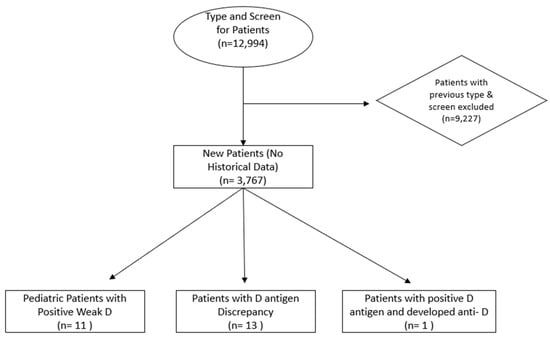
Figure 1
Open AccessArticle
Analyzing Clinical Parameters and Bacterial Profiles to Uncover the COPD Exacerbations: A Focus on Intensive Care Unit Challenges
by
Dragoș Huțanu, Hédi-Katalin Sárközi, Mara Andreea Vultur, Adrian-Horațiu Sabău, Iuliu Gabriel Cocuz, Corina Mărginean, Andra-Maria Chelemen and Corina Eugenia Budin
Medicina 2025, 61(4), 669; https://doi.org/10.3390/medicina61040669 (registering DOI) - 5 Apr 2025
Abstract
Background and Objectives: Chronic obstructive pulmonary disease (COPD) poses a significant healthcare challenge worldwide, frequently leading to exacerbations necessitating intensive care unit admissions for potentially life-threatening complications. We aimed to investigate correlations between laboratory parameters, bacteriological agents, ventilation mode, and survival rates among
[...] Read more.
Background and Objectives: Chronic obstructive pulmonary disease (COPD) poses a significant healthcare challenge worldwide, frequently leading to exacerbations necessitating intensive care unit admissions for potentially life-threatening complications. We aimed to investigate correlations between laboratory parameters, bacteriological agents, ventilation mode, and survival rates among COPD patients admitted to the ICU. Materials and Methods: Data were collected from the Pulmonology Department of Mures Clinical County Hospital, Romania, from 1 January 2022 to 30 October 2023. Eighty-four COPD patients required ICU transfer, except for concurrent SARS-CoV-2 infections. Results: Ventilation modes exhibited a significant correlation with specific bacteriological agents, orotracheal intubation being more prevalent in infections with Acinetobacter baumanii, Staphylococcus aureus, and Streptococcus pneumoniae (p < 0.001). Negative cultures were predominantly found in patients managed with non-invasive ventilation. Laboratory parameters revealed an association between elevated white blood cell counts and bacteriological superinfection, particularly with Escherichia coli (p < 0.001). Different bacteriological agents had different survival rates. Patients infected with Acinetobacter baumanii exhibited the highest mortality rate, while those with Staphylococcus aureus had the lowest (p < 0.01). Conclusions: The importance of prompt evaluation of laboratory parameters and bacteriological findings is underscored by these findings, particularly in ICU settings where ventilation and bacteriological profiles influence patient outcomes. The identification of elevated WBC counts is a marker of bacterial superinfection. The association between specific bacterial agents and ventilation modes highlights the importance of tailored treatment based on microbial profiles. These insights can be applied to refine treatment protocols and enhance survival rates in severe COPD exacerbations that require ICU management.
Full article
(This article belongs to the Special Issue Personalized Medicine for Patients with Respiratory Disease)
►▼
Show Figures

Figure 1
Open AccessArticle
The Effects of Virtual Reality-Based Task-Oriented Movement on Upper Extremity Function in Healthy Individuals: A Crossover Study
by
Tuba Maden, Halil İbrahim Ergen, Zarife Pancar, Antonio Buglione, Johnny Padulo, Gian Mario Migliaccio and Luca Russo
Medicina 2025, 61(4), 668; https://doi.org/10.3390/medicina61040668 (registering DOI) - 4 Apr 2025
Abstract
Background and Objectives: Although virtual reality (VR) has been shown to be effective in rehabilitation through motor learning principles, its impact on upper extremity function, particularly in the context of console use, remains unclear. Materials and Methods: This study aimed to
[...] Read more.
Background and Objectives: Although virtual reality (VR) has been shown to be effective in rehabilitation through motor learning principles, its impact on upper extremity function, particularly in the context of console use, remains unclear. Materials and Methods: This study aimed to investigate the effects of VR-based task-oriented movement on the upper extremity of healthy individuals. A total of 26 healthy individuals performed task-oriented movements in both real and virtual environments in a randomized order. All participants completed a single session of task-oriented movements using a VR Goggle system in a virtual setting. Physiotherapists designed immersive VR-based experiences and 3D screen-based exergames for this study. Upper extremity function was assessed using several measures: joint position sense (JPS) of the wrist and shoulder was evaluated using a universal goniometer, reaction time was measured via a mobile application, and gross manual dexterity was assessed using the box-and-block test (BBT). Evaluations were conducted before and after the interventions. Results: The results showed that JPS remained similar between conditions, while BBT performance improved in both groups. However, the reaction time increased significantly only after VR intervention (p < 0.05). No significant period or carryover effects were observed across the parameters. These findings suggest that VR-based task-oriented training positively influences reaction time and supports hand function. Moreover, VR systems that simulate joint position sense similar to real-world conditions may be beneficial for individuals with musculoskeletal motor deficits. Conclusions: These results highlight the potential for integrating VR technology into rehabilitation programs for patients with neurological or orthopedic impairments, providing a novel tool for enhancing upper extremity function and injury prevention strategies.
Full article
(This article belongs to the Special Issue Advancement in Upper Limb Rehabilitation and Injury Prevention)
►▼
Show Figures
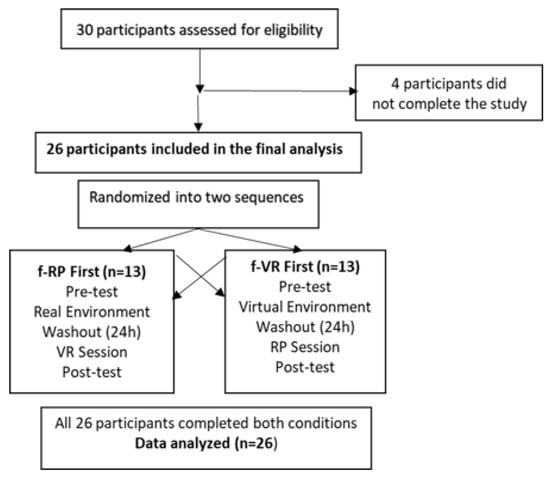
Figure 1
Open AccessArticle
Evaluation of Prefrontal Cortex Activation and Static Balance Mechanisms in Adolescent Idiopathic Scoliosis Using fNIRS
by
Esra Suzen, Kadriye Tombak, Buket Simsek, Omer Halil Colak and Sukru Ozen
Medicina 2025, 61(4), 667; https://doi.org/10.3390/medicina61040667 (registering DOI) - 4 Apr 2025
Abstract
Background and Objectives: In this study, the role of oxyhemoglobin (HbO) in subregions of the prefrontal cortex during a static balance task under eyes-open and eyes-closed conditions was investigated in adolescent idiopathic scoliosis (AIS) using functional near-infrared spectroscopy (fNIRS), a powerful neuroimaging tool
[...] Read more.
Background and Objectives: In this study, the role of oxyhemoglobin (HbO) in subregions of the prefrontal cortex during a static balance task under eyes-open and eyes-closed conditions was investigated in adolescent idiopathic scoliosis (AIS) using functional near-infrared spectroscopy (fNIRS), a powerful neuroimaging tool that enables more natural and flexible measurement in the analysis of balance mechanisms and motor tasks. Materials and Methods: Hemodynamic changes in the right and left dorsolateral cortex (DLPFC), frontopolar prefrontal cortex, and orbitofrontal cortex were analyzed in 16 healthy controls and 15 individuals with AIS. The statistical results were supported by HbO contrast maps. Results: Significant differences were found in the cortical activity patterns between the AIS and control groups. The AIS group had lower HbO concentrations than the control group in the eyes-closed condition and completely differed from the control group by showing more active HbO concentrations in the DLPFC regions than in the frontopolar regions. In the eyes-open condition, it was found that the maximum HbO value was reached in the frontopolar regions, and this value was weakened and observed throughout the left frontopolar region. Discriminative differences were also found in the orbitofrontal region in the eyes-closed static balance condition. Conclusions: The results obtained were evaluated and discussed in terms of postural balance compensation, differences in neural pathways, and the conscious balance mechanism. It was determined that the AIS group tended to utilize a conscious balance mechanism in the eyes-closed static balance condition and developed its own balance compensation mechanism in the eyes-open static balance condition. This study concludes that fNIRS is a powerful tool in the evaluation of balance and control mechanisms and can be used effectively in the evaluation of rehabilitation-oriented development in AIS.
Full article
(This article belongs to the Section Neurology)
►▼
Show Figures
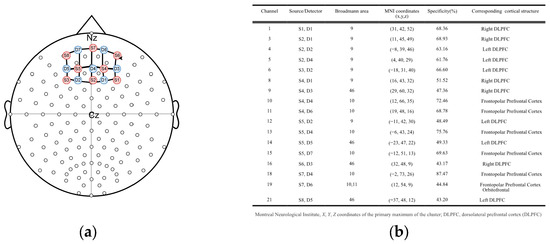
Figure 1
Open AccessSystematic Review
Anatomical Variants in Pancreatic Irrigation and Their Clinical Considerations for the Pancreatic Approach and Surrounding Structures: A Systematic Review with Meta-Analysis
by
Juan José Valenzuela-Fuenzalida, Camila Ignacia Núñez-Castro, Valeria Belén Morán-Durán, Pablo Nova-Baeza, Mathias Orellana-Donoso, Alejandra Suazo-Santibáñez, Alvaro Becerra-Farfan, Gustavo Oyanedel-Amaro, Alejandro Bruna-Mejias, Guinevere Granite, Daniel Casanova-Martinez and Juan Sanchis-Gimeno
Medicina 2025, 61(4), 666; https://doi.org/10.3390/medicina61040666 (registering DOI) - 4 Apr 2025
Abstract
Background and Objectives: The pancreas receives blood through a complex network of multiple branches, primarily originating from the celiac trunk (CeT) and the superior mesenteric artery (SMA). This blood supply is structured into three main arterial groups, each serving different regions of
[...] Read more.
Background and Objectives: The pancreas receives blood through a complex network of multiple branches, primarily originating from the celiac trunk (CeT) and the superior mesenteric artery (SMA). This blood supply is structured into three main arterial groups, each serving different regions of the pancreas to effectively support its endocrine and exocrine functions. Materials and Methods: The databases Medline, Scopus, Web of Science, Google Scholar, Cumulative Index to Nursing and Allied Health Literature (CINAHL) and Latin American and the Caribbean Literature in Health Sciences (LILACS) were searched until January 2025. Methodological quality was evaluated using an assurance tool for anatomical studies (AQUA). Pooled prevalence was estimated using a random effects model. Results: A total of sixteen studies met the established selection criteria in this study for meta-analysis. Pancreatic irrigation variants presented a prevalence of 11.2% (CI: 7–14%) and a heterogeneity of 88.2%. The other studies were analyzed by subgroups, showing statistically significant differences in the following subgroups: (1) sample type—a larger sample of images analyzed in the included studies (p = 0.312), which did not show statistically significant differences; (2) geographical region (p = 0.041), which showed a greater presence in the Asian population studied, and this was statistically significant; and (3) sex (male or female) (p = 0.12), where there were no statistically significant differences. Conclusions: The discovery of variations in pancreatic irrigation is common due to the numerous blood vessels involved in supplying this vital organ. Understanding different vascular patterns (such as those from the splenic and mesenteric arteries) is crucial for surgical interventions on the pancreas. For transplant patients, a thorough vascular analysis of both the donor and recipient is essential. Variations can impact blood flow and compatibility, potentially leading to transplant rejection if not addressed. To enhance outcomes, it is recommended to develop more accurate imaging tools for pre-surgical analysis, necessitating ongoing research in this area.
Full article
(This article belongs to the Special Issue Clinical Anatomy in the 21st Century: Understanding the Possible Basis of Certain Pathologies and Clinical Symptoms)
►▼
Show Figures

Figure 1
Open AccessArticle
Comparative Analysis of Cardiac SPECT Myocardial Perfusion Imaging: Full-Ring Solid-State Detectors Versus Dedicated Cardiac Fixed-Angle Gamma Camera
by
Gytis Aleksa, Paulius Jaruševičius, Andrė Pacaitytė and Donatas Vajauskas
Medicina 2025, 61(4), 665; https://doi.org/10.3390/medicina61040665 - 4 Apr 2025
Abstract
Background and Objectives: Single-photon emission computed tomography (SPECT) myocardial perfusion imaging (MPI) is a well-established technique for evaluating myocardial perfusion and function in patients with suspected or known coronary artery disease. While conventional dual-detector SPECT scanners have limitations in spatial resolution and photon
[...] Read more.
Background and Objectives: Single-photon emission computed tomography (SPECT) myocardial perfusion imaging (MPI) is a well-established technique for evaluating myocardial perfusion and function in patients with suspected or known coronary artery disease. While conventional dual-detector SPECT scanners have limitations in spatial resolution and photon detection sensitivity, recent advancements, including full-ring solid-state cadmium zinc telluride (CZT) detectors, offer enhanced image quality and improved diagnostic accuracy. This study aimed to compare the performance of Veriton-CT, a full-ring CZT SPECT system, with GE Discovery 530c, a dedicated cardiac fixed-angle gamma camera, in myocardial perfusion imaging and their correlation with coronary angiography findings. Materials and Methods: This was a prospective study that analyzed 21 patients who underwent MPI at the Department of Nuclear Medicine, Lithuanian University of Health Sciences, Kauno Klinikos. A one-day stress–rest protocol using 99mTc-Sestamibi was employed, with stress testing performed via bicycle ergometry or pharmacological induction. MPI was first conducted using GE Discovery 530c (GE Health Care, Boston, MA, USA), followed by imaging on Veriton-CT, which included low-dose CT for attenuation correction. The summed stress score (SSS), summed rest score (SRS), and summed difference score (SDS) were analyzed and compared between both imaging modalities. Coronary angiography results were retrospectively collected, and lesion-based analysis was performed to assess the correlation between imaging results and the presence of significant coronary artery stenosis (≥35% and ≥70% narrowing). Image quality and the certainty of distinguishing the inferior myocardial wall from extracardiac structures were also evaluated by two independent researchers with differing levels of experience. Results: Among the 14 patients included in the final analysis, Veriton-CT was more likely to classify MPI scans as normal (64.3%) compared to GE Discovery 530c (28.6%). Additionally, Veriton-CT provided a better assessment of the right coronary artery (RCA) basin, showing greater agreement with coronary angiography findings than GE Discovery 530c, although the difference was not statistically significant. No significant differences in lesion overlap were observed for the left anterior descending artery (LAD) or left circumflex artery (LCx) basins. Furthermore, the image quality assessment revealed slightly better delineation of extracardiac structures using Veriton-CT (Spectrum Dynamics Medical, Caesarea, Israel), particularly when evaluated by an experienced researcher. However, no significant difference was observed when assessed by a less experienced observer. Conclusions: Our findings suggest that Veriton-CT, with its full-ring CZT detector system, may offer advantages over fixed-angle gamma cameras in improving image quality and reducing attenuation artifacts in MPI. Although the difference in correlations with coronary angiography findings was not statistically significant, Veriton-CT showed a trend toward better agreement, particularly in the RCA basin. These results indicate that full-ring SPECT imaging could improve the diagnostic accuracy of non-invasive MPI, potentially reducing the need for unnecessary invasive angiography. Further studies with larger patient cohorts are required to confirm these findings and evaluate the clinical impact of full-ring SPECT technology in myocardial perfusion imaging.
Full article
(This article belongs to the Section Cardiology)
►▼
Show Figures

Figure 1
Open AccessReview
New Frontiers in Nutritional and Therapeutic Interventions for Obesity Phenotypes
by
Angelo Maria Patti, Rosaria Vincenza Giglio, Marcello Ciaccio, Anca Pantea Stoian, Teodor Salmen, Ioana-Cristina Bica, Imran Rangraze, Mohamed El Tanani, Manfredi Rizzo and Ali Abbas Rizvi
Medicina 2025, 61(4), 664; https://doi.org/10.3390/medicina61040664 (registering DOI) - 3 Apr 2025
Abstract
The heterogeneity among patients with obesity is particularly evident in the weight loss response to interventions such as diets, drugs, devices and surgery. Obesity can be “catalogued” into four phenotypes: hungry brain (abnormal satiety for alteration of gut–brain axis), emotional hunger (hedonic eating),
[...] Read more.
The heterogeneity among patients with obesity is particularly evident in the weight loss response to interventions such as diets, drugs, devices and surgery. Obesity can be “catalogued” into four phenotypes: hungry brain (abnormal satiety for alteration of gut–brain axis), emotional hunger (hedonic eating), hungry gut (abnormal duration of satiety for faster gastric emptying) and slow burning (slowing of the metabolic rate). Phenotypes are grafted onto this complexity, the recognition of which allows for personalized medicine and increasingly targeted therapies. Although there are no standardized treatment protocols, we present management options consisting of lifestyle modifications and pharmacologic therapies. Nutritional advice and encouragement of adequate physical activity lead to increased self-efficacy and promote a sense of well-being when coupled with psychological approaches involving mindful eating. In summary, obesity has a complex pathophysiology best addressed through a therapeutic process suited to the phenotype encountered and in synergy with multifactorial interventions.
Full article
(This article belongs to the Section Endocrinology)
►▼
Show Figures
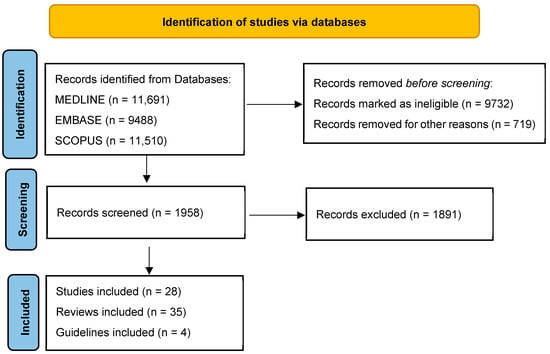
Figure 1
Open AccessArticle
Unipedicular vs. Bipedicular Balloon Kyphoplasty in the Treatment of Osteoporotic Vertebral Compression Fractures: Single-Institute 3-Year Follow-Up Results
by
Tolga Ege, Uğur Yüzügüldü, Ali Murat Başak, Mustafa Aydın, Ömer Erşen and Tuluhan Yunus Emre
Medicina 2025, 61(4), 663; https://doi.org/10.3390/medicina61040663 - 3 Apr 2025
Abstract
Background and Objectives: Balloon kyphoplasty is one of the most commonly performed minimally invasive surgical procedures for the treatment of osteoporotic vertebral fractures, with the bipedicular technique being the conventional approach. However, the use of both pedicles may present certain disadvantages, including higher
[...] Read more.
Background and Objectives: Balloon kyphoplasty is one of the most commonly performed minimally invasive surgical procedures for the treatment of osteoporotic vertebral fractures, with the bipedicular technique being the conventional approach. However, the use of both pedicles may present certain disadvantages, including higher costs, longer operative times, increased radiation exposure, and a greater risk of bone cement leakage. This study aims to report the 3-year follow-up outcomes of double-pedicle and single-pedicle kyphoplasty performed at our institution. Materials and Methods: Between June 2016 and May 2019, a total of 136 patients who presented to our clinic with osteoporotic vertebral fractures and underwent balloon kyphoplasty were included in this retrospective study. Pain relief and quality of life indices were assessed preoperatively and postoperatively. During follow-up examinations, radiographs, VAS (Visual Analog Scale) scores, and ODI (Oswestry Disability Index) scores were evaluated. Radiation exposure was assessed using fluoroscopy time and dose area product (DAP) values. Additionally, total injected cement volume, operative time, and procedural complications were retrieved from patient records. Results: The procedure was successful in all patients. The mean bone cement volume used was 3.4 ± 1.4 mL in the unipedicular group and 5.3 ± 2.1 mL in the bipedicular group. Fluoroscopy time and DAP values were significantly higher in the bipedicular technique compared to the unipedicular technique. At the final follow-up, the average kyphosis correction and mean vertebral height correction ratio were greater in the bipedicular group. The mean reduction in VAS and ODI scores was superior in the bipedicular group at the 1-, 2-, and 6-month follow-ups. However, at the 1-, 2-, and 3-year follow-ups, there was no significant difference in VAS and ODI scores between the two groups. Conclusions: The unipedicular balloon kyphoplasty technique offers several advantages, including shorter operative time, lower cement leakage risk, reduced radiation exposure, and comparable pain score reductions at 1- to 3-year follow-ups. However, the bipedicular technique provides superior short-term pain relief and demonstrates better sagittal alignment correction in long-term follow-ups compared to the unipedicular approach.
Full article
(This article belongs to the Section Orthopedics)
►▼
Show Figures

Figure 1
Open AccessEditorial
Editorial to the Special Issue “Retinopathies: A Challenge for Early Diagnosis, Innovative Treatments, and Reliable Follow-Up”
by
Dario Rusciano and Stefania Marsili
Medicina 2025, 61(4), 662; https://doi.org/10.3390/medicina61040662 - 3 Apr 2025
Abstract
The Special Issue “Retinopathies: A Challenge for Early Diagnosis, Innovative Treatments, and Reliable Follow-Up” brings together a diverse yet interconnected collection of research papers that collectively address the multifaceted challenges of retinal diseases [...]
Full article
(This article belongs to the Special Issue Retinopathies: A Challenge for Early Diagnosis, Innovative Treatments and Reliable Follow-Up)
Open AccessBrief Report
Hemodynamic Performance of a Self-Expanding Transcatheter Aortic Valve with an Intra-Annular Leaflet Position in Patients with a Small Aortic Annulus
by
Matjaž Bunc, Gregor Verček and Ole De Backer
Medicina 2025, 61(4), 661; https://doi.org/10.3390/medicina61040661 - 3 Apr 2025
Abstract
Background and Objectives: Transcatheter aortic valve implantation is associated with a higher risk for elevated trans-prosthetic gradients and prosthesis-patient mismatch in patients with a small aortic annulus. We aimed to assess the short-term hemodynamic performance of self-expanding transcatheter aortic valves with an
[...] Read more.
Background and Objectives: Transcatheter aortic valve implantation is associated with a higher risk for elevated trans-prosthetic gradients and prosthesis-patient mismatch in patients with a small aortic annulus. We aimed to assess the short-term hemodynamic performance of self-expanding transcatheter aortic valves with an intra-annular leaflet position in patients with small aortic anatomies. Materials and Methods: Consecutive patients with small aortic annuli (annular area < 430 mm2), who underwent transcatheter aortic valve implantation with a self-expanding Portico or Navitor (Abbott Medical, St. Paul, MN, USA) transcatheter aortic valve between October 2017 and August 2024 at the University Medical Centre Ljubljana, Slovenia, were analyzed. The main endpoints were the post-procedural mean trans-prosthetic gradient, the presence of moderate or severe prosthesis-patient mismatch or paravalvular regurgitation. Results: Overall, 37 patients were included in the study (29 patients with a native aortic valve and 8 patients undergoing valve-in-valve transcatheter aortic valve implantation). The mean age was 81.6 ± 4.3 years, 32 patients (86.5%) were female. The median annular perimeter was 70.8 mm (interquartile range 67.3–74.1 mm) and the median annular area was 379 mm2 (interquartile range 355–412 mm2). The post-procedural mean trans-prosthetic gradient was 9.0 ± 3.5 mmHg, with no cases with a mean gradient > 20 mmHg. Moderate and severe prosthesis-patient mismatch was observed in 21.2% and 3.0% of patients, respectively. Mild paravalvular regurgitation was noted in 44.1% of patients, there were no cases of moderate or severe paravalvular regurgitation. One patient (3.0%) had moderate valvular regurgitation. Conclusions: Self-expanding transcatheter aortic valves with an intra-annular leaflet position are associated with favorable hemodynamic performance in patients with a small aortic annulus.
Full article
(This article belongs to the Section Cardiology)
►▼
Show Figures

Figure 1
Open AccessReview
Significance of Demodex folliculorum and Demodex brevis in Pathogenesis of Dermatological Diseases—Current State of Knowledge
by
Katarzyna Rychlik, Julia Sternicka, Roman J. Nowicki, Leszek Bieniaszewski and Dorota Purzycka-Bohdan
Medicina 2025, 61(4), 660; https://doi.org/10.3390/medicina61040660 - 3 Apr 2025
Abstract
Demodex folliculorum and Demodex brevis are external parasites that reside in human hair follicles and sebaceous glands, most commonly on the cheeks, chin, nose, and eyelids, inhabiting the eyelash follicles. The prevalence of Demodex spp. varies with age. The highest concentration of mites
[...] Read more.
Demodex folliculorum and Demodex brevis are external parasites that reside in human hair follicles and sebaceous glands, most commonly on the cheeks, chin, nose, and eyelids, inhabiting the eyelash follicles. The prevalence of Demodex spp. varies with age. The highest concentration of mites is observed in older people, being almost 100%, and the lowest is found in children. Although the presence of parasites does not directly lead to the development of pathological symptoms, their high density is associated with diseases such as rosacea or blepharitis. This manuscript delves into the biological characteristics of Demodex folliculorum and Demodex brevis with consideration of current diagnostic techniques for detecting Demodex mites. It also aims to provide an in-depth analysis of the role Demodex mites play in the development of various dermatological conditions, with a review of the current therapeutic approaches for managing Demodex-related diseases.
Full article
(This article belongs to the Section Infectious Disease)
►▼
Show Figures

Figure 1
Open AccessSystematic Review
Systematic Review and Meta-Analysis of Transcendental Meditation for Post-Traumatic Stress Disorder
by
David W. Orme-Johnson, Vernon A. Barnes, Brian Rees and Jean Tobin
Medicina 2025, 61(4), 659; https://doi.org/10.3390/medicina61040659 - 3 Apr 2025
Abstract
Background and Objectives. Our recent systematic review and meta-analysis of all studies on meditation as treatment for PTSD (61 studies) found a moderate effect size of Hedges’s g = −0.67 for post-minus-pre change in symptom scores. Separate tests of the four meditation categories
[...] Read more.
Background and Objectives. Our recent systematic review and meta-analysis of all studies on meditation as treatment for PTSD (61 studies) found a moderate effect size of Hedges’s g = −0.67 for post-minus-pre change in symptom scores. Separate tests of the four meditation categories found a large effect size of g = −1.13 for the Transcendental Meditation (TM) technique that is significantly greater than for each other category. The present follow-up used a different method, calculating effects relative to internal controls, to better characterize the effects of this meditation technique. Materials and Methods. Our study followed Prisma guidelines. Major databases, research anthologies, and bibliographies were searched for studies that used TM for treating PTSD, all military and civilian populations, and all age groups. Results. The searches located 15 controlled trials on TM that met the inclusion criteria (longitudinal and reporting sufficient statistics to calculate effect sizes), 1248 subjects total, mean age 40.5 years (range 20.6 to 54.4 years), and 46.9% males (range 0% to 100%). Using the random effects model, the pooled effect across all studies of TM compared to other treatments was g = −1.01, 95% CI = −1.29 to −0.74, p < 0.000000001. One-study removed analysis found that no study reduced the pooled effect to less than −1.0. Funnel plots indicated no risk of bias. TM was non-inferior to prolonged exposure therapy, p = 0.0001, and it worked significantly faster (p = 0.04 at week six). Conclusions. TM produced clinically meaningful reductions in PTSD for civilian and military personnel, young and older adults, and for both men and women. We recommend phase-III multisite studies comparing TM with known first-line treatments for PTSD.
Full article
(This article belongs to the Special Issue Transcendental Meditation and Treatment for Stress)
►▼
Show Figures

Graphical abstract

Journal Menu
► ▼ Journal Menu-
- Medicina Home
- Aims & Scope
- Editorial Board
- Reviewer Board
- Topical Advisory Panel
- Instructions for Authors
- Special Issues
- Topics
- Sections & Collections
- Article Processing Charge
- Indexing & Archiving
- Editor’s Choice Articles
- Most Cited & Viewed
- Journal Statistics
- Journal History
- Journal Awards
- Society Collaborations
- Conferences
- Editorial Office
Journal Browser
► ▼ Journal BrowserHighly Accessed Articles
Latest Books
E-Mail Alert
News
Topics
Topic in
JCM, JPM, Medicina, Osteology, Surgeries
Orthopaedic Diseases and Innovative Intervention Strategies, 2nd Volume
Topic Editors: Umile Giuseppe Longo, Vicenzo DenaroDeadline: 31 May 2025
Topic in
Cancers, Healthcare, JCM, JPM, Medicina
Public Health and Healthcare in the Context of Big Data
Topic Editors: Mingzhe Ma, Xi Yang, Ruogu QiDeadline: 5 July 2025
Topic in
Cancers, Current Oncology, JCM, Medicina, Onco
Cancer Biology and Radiation Therapy: 2nd Edition
Topic Editors: Chang Ming Charlie Ma, Ka Yu Tse, Ming-Yii Huang, Mukund SeshadriDeadline: 16 October 2025
Topic in
Clinics and Practice, Cosmetics, JCM, Medicina, Dermato, LabMed, Psychology International
Advances in Psychodermatology
Topic Editors: Jacek C Szepietowski, Andrzej JaworekDeadline: 30 November 2025

Conferences
Special Issues
Special Issue in
Medicina
Advancements in Cardiovascular Medicine and Interventional Radiology
Guest Editors: Juš Kšela, Dimitrij Kuhelj, Matjaz BuncDeadline: 10 April 2025
Special Issue in
Medicina
Contemporary Trends in Urothelial Cancer Management
Guest Editors: Panagiotis Mourmouris, Nikolaos KostakopoulosDeadline: 15 April 2025
Special Issue in
Medicina
Diabetes and Obesity: What is New in 2025
Guest Editors: Manfredi Rizzo, Ali Abbas RizviDeadline: 15 April 2025
Special Issue in
Medicina
Precision Medicine Approach in Septic Patients
Guest Editors: Gabriela Droc, Sebastian IsacDeadline: 20 April 2025
Topical Collections
Topical Collection in
Medicina
New Concepts for Dental Treatments and Evaluations
Collection Editors: Cosmin Sinescu, Virgil-Florin Duma
Topical Collection in
Medicina
Advances in Cornea, Cataract, and Refractive Surgery
Collection Editor: Ivo Guber
Topical Collection in
Medicina
Pain, Bleeding, Trauma and Infections: The 4 Horsemen of the Apocalypse for the Emergency Medicine
Collection Editor: Marcello Candelli
Topical Collection in
Medicina
Frontiers in Breast Cancer Diagnosis and Treatment
Collection Editors: Jimmy T. Efird, Tithi Biswas





